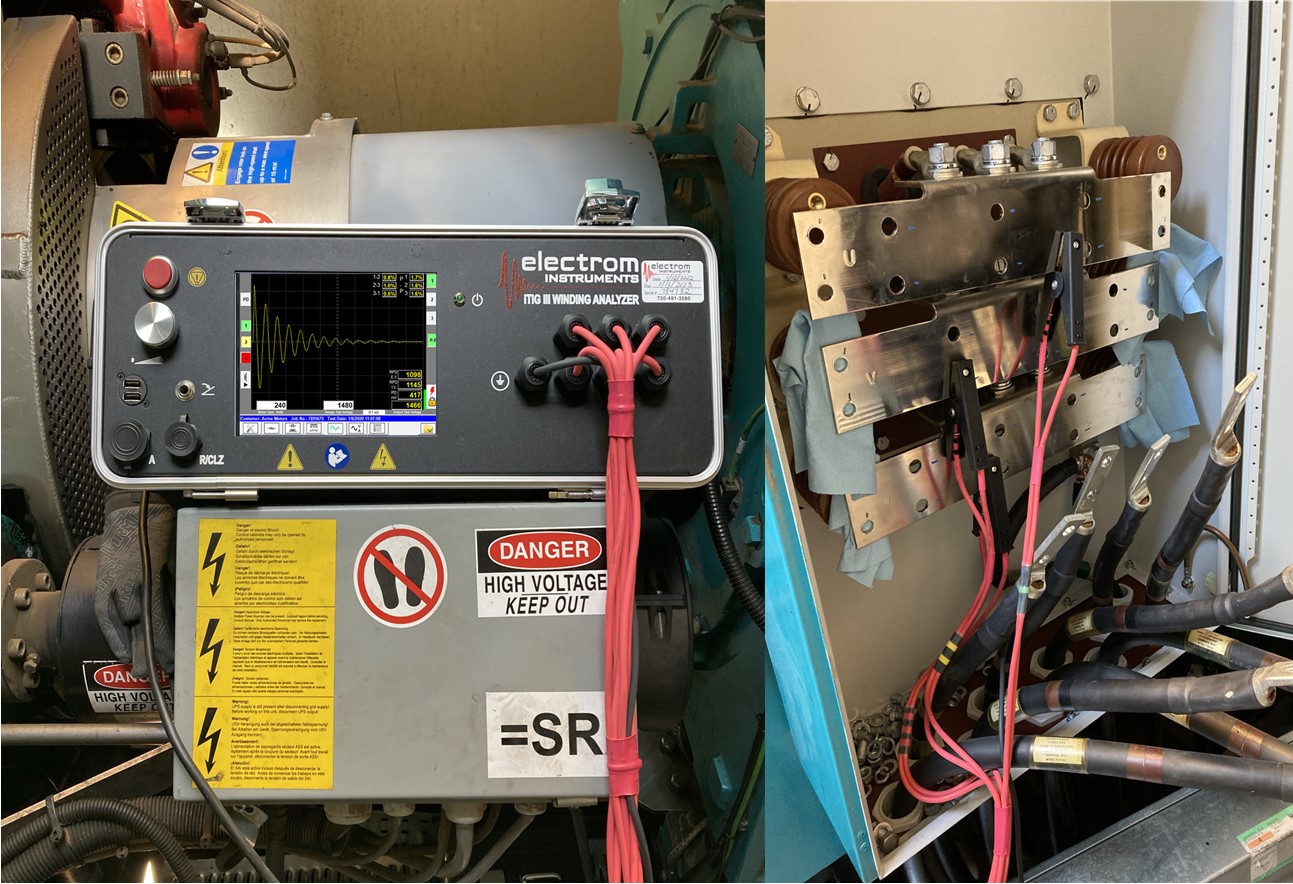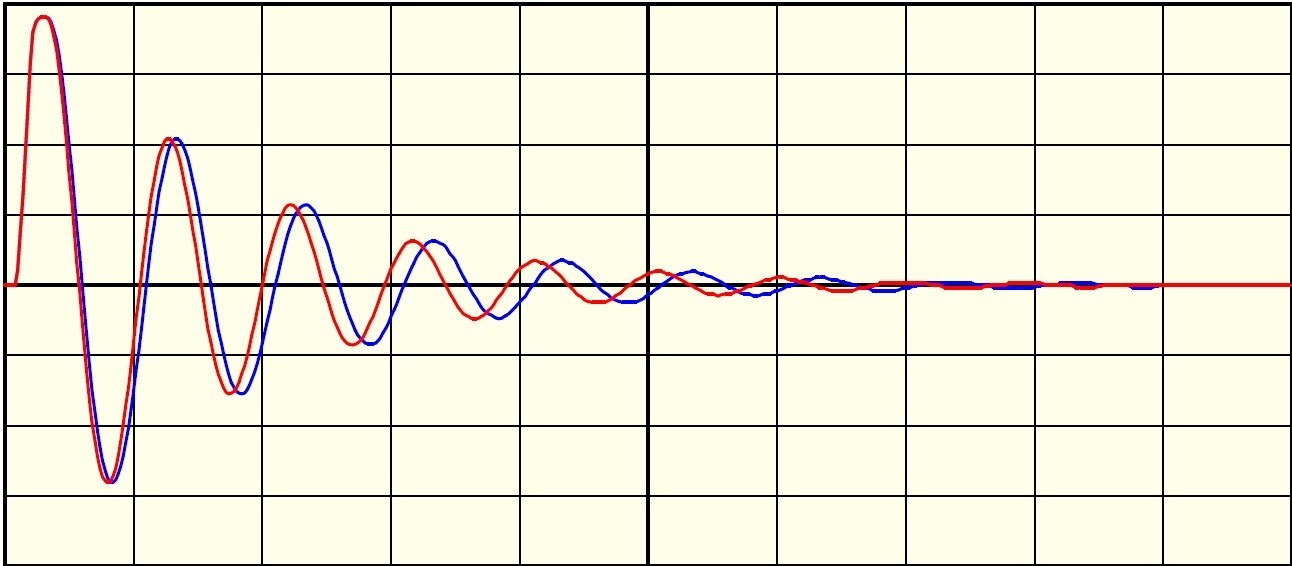Surge Testing: Minimize downtime and control operating expenses
The surge test, also known as a surge comparison test, is essential for wind farm operators and maintenance technicians who want to predict generator failures using a data-centric approach. This test can be conducted on generators, as well as auxiliary motors used in cooling systems, automated lubrication devices, nacelle yaw motors, and blade pitch motors.

Image 1: A winding analyzer with its test leads connected to a generator up-tower in preparation for a surge comparison test.
When performed during a regular maintenance schedule, the surge test gives users trending data so that O&Ms can prioritize wind turbine servicing and schedule maintenance, rather than risk unplanned downtime. In some cases, smaller repairs can be made up-tower, which can defer or even eliminate the need to extract the generator or other motors.
Why is the surge test important?
Surge comparison testing gives a complete picture of stator and rotor insulation condition. In fact, it’s the only test that finds insulation weakness between turns, or turn-to-turn, in generator and motor windings. These weaknesses cannot be found with other tests commonly used by O&Ms, such as insulation resistance/megohm (sometimes called a megger test) and high-potential (hipot) tests.
The surge comparison test finds turn-to-turn weaknesses by stressing the winding’s insulation at a voltage above operating voltage, so that both weaknesses and hard shorts can be found. In most cases, pass/fail determinations are easy to make, helping to clearly define data-driven decisions for the type of generators and motors in use.
Winding failure progression
Wind generators and motors used in wind turbines are subject to harsh environmental conditions; they can progress to failure in many ways. A common progression of winding failures starts as insulation weakness. If undetected, insulation weaknesses will first cause turn-to-turn shorts, which then lead to ground wall insulation breakdown and winding failure.
Partial discharges (PD) are the first evidence of weakness — these can be detected with a winding analyzer using the surge test with PD detection circuitry and software. Most medium-voltage and high-voltage generators and motors are designed to withstand some amount of PD. Therefore, the presence of PD may not indicate a problem. Tracking PD activity over time, or comparing PD activity to that in other machines, provides important information about the condition of the windings and breakdown of the insulation. PD detected in low-voltage equipment is considered a problem.
As winding insulation continues to weaken, the surge test is the best method for detecting the problem early. If weaknesses are found above operating voltage, the generator or motor can continue to run while remedial actions are scheduled.
Once insulation weakness causes a turn-to-turn arc, heat creates a hot spot. The hot spot causes more turns to arc and short out, releasing more heat. Eventually, the windings short to ground, and the generator or motor fails.
How does the surge test work?
The surge test involves injecting high-frequency voltage surges into the windings, then recording the resulting waveforms through an oscilloscope channel in a winding analyzer. Comparisons are made between the phases (phase-to-phase) of the generator or motor, as well as between each surge pulse (pulse-to-pulse). If the tested winding’s waveforms deviate significantly phase-to-phase or pulse-to-pulse from the norm, it indicates weak insulation is present.
The shape and number of oscillations of the wave depends on the rotor and the specific construction of the generator or motor. The frequency of the waveform is inversely proportional to the number of turns. Therefore, a winding with fewer turns will produce a higher frequency wave.

Image 2: Windings with fewer turns produce higher frequency waveforms (A), and windings with more resistive, eddy-current, and hysteresis losses produce more dampening and fewer wave peaks (B).
During a surge test, the winding analyzer increases the voltage of each pulse, and compares the resulting surge waves by calculating a percent wave difference. If the generator or motor loses a turn due to an arc or short, the frequency of the waveform increases. On the test screen, this appears as though the wave suddenly shifts to the left. When this happens, the percentage difference between waves increases. If the difference is above the test operator’s pass/fail threshold, the surge test is considered failed.

Image 3: If the generator or motor loses a turn because of an arc caused by week insulation or a short, the frequency of the waveform increases causing it to appear to shift left. In this test, the blue waveform is from the pulse before the arc and the red waveform is from the pulse that arced.
Is the surge test destructive?
The surge test is not destructive for two reasons. First, the energy in each surge pulse is low. Second, the duration of the over-voltage period is very short. A good analogy is a static electric discharge arcing from your finger to a doorknob; you may be able to feel it, but there is no burn mark or damage, even though the arc voltage may be 20,000V.
Motors are designed to handle voltages far above normal surge test voltages. For example, it is not uncommon to see 460-volt (V) motors arc around 10,000 V. Even old 460 V motors have been seen to arc around 8,000 V. Compare that to normal surge test voltage for 460 V motors of around 2,000 V. Furthermore, motors and coils in laboratory settings have been surge tested millions of times with no discernable change in the insulation properties.
Recommended practices
The American Wind Energy Association (AWEA), now American Clean Power (ACP), recommends surge comparison testing. According to Operations and Maintenance Recommended Practices (version 2017, Chapter 2 Generator and Electrical), the surge comparison test is the most common analysis tool for testing turn-to-turn insulation in motors and generators. Many other low-voltage and high-voltage tests are recommended as well, and “modern automated winding analysis equipment combines many of these tests into a concise report and is very useful for predictive maintenance practices.”
Conclusion
Surge tests are critical for wind industry operators and maintenance professionals. They are the only tests that find turn-to-turn insulation weaknesses. These weaknesses are precursors to serious failures and shutdown of rotating equipment.
The surge test is important for predictive maintenance purposes because it can find cases of weak insulation before the machine progresses to complete failure. This allows O&M maintenance programs to schedule maintenance, rather than risk unplanned downtime.
David Stewart is marketing manager at Electrom Instruments. He may be reached at [email protected].
Electrom Instruments | electrominst.com
Author: David Stewart
Volume: 2023 March/April









